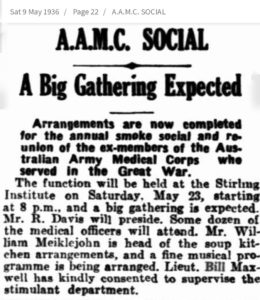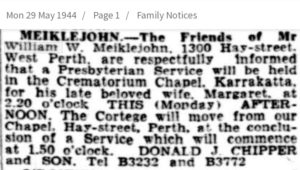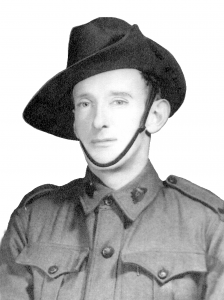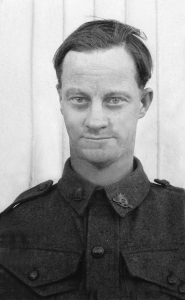MURADUP – THE OLDEST WW1 WAR MEMORIAL IN AUSTRALIA
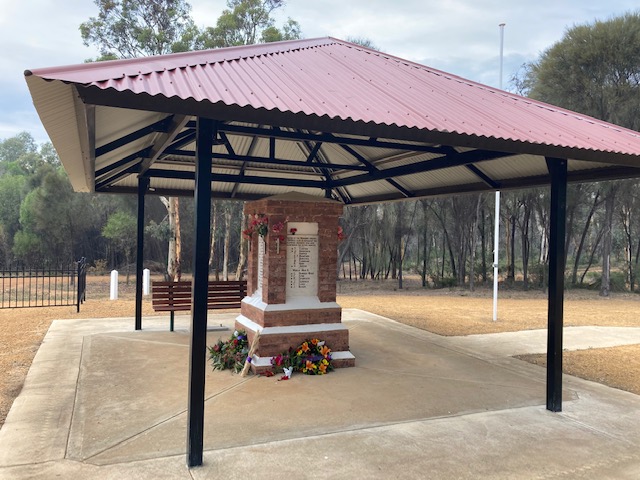
Constructed in 1916, it is believed Muradup War Memorial was one of the first WW1 Memorials to be erected in Australia – a significant forward-planning act on the part of the local population.
Of course Muradup with its railway siding, was home to a larger community than it is today. There was a school, local co-op, hall, garage and other small businesses and hosted numerous sporting interests.
Muradup War Memorial
The War Memorial commemorates those from the Muradup Football and Cricket Clubs who served in World War One, World War Two, the Malayan Emergency and the Borneo Confrontation. The monument was originally erected to commemorate those from the district who enlisted in World War One.
The memorial was refurbished and re-dedicated in 2005 and underwent another re-dedication ceremony on the 24th September 2016 to commemorate the centenary of the unveiling of the memorial.
‘Great Southern Herald, 15 January 1916
A meeting of the Muradup Cricket Club was held on January 9, when nearly all members of the club were present, and, after the general business, the club decided to erect a “scroll of honor” with the names of all the members of the Muradup Football and Cricket Clubs who have left for the front. The names up to the present total 17, viz., Levi Treasure, Leo Treasure, Henry Treasure, A Chipper, H Hart, T Urquhart, G White, L A Coe, T Rogerson, W McFarlane, L Glover, E Ashe, J Ashe, C Lacine, W Meiklejohn, F Norrish and J Veitch. These names will be inscribed on the scroll with the consent of the relatives.’
Please take a moment to listen and watch MURADUP’S 2018 MEMORIAL SERVICE CELEBRATING 100 YEARS

Please Note: should read Parker G. (Miss)
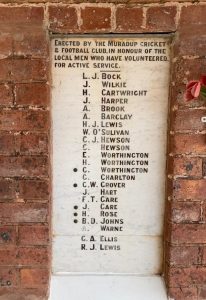
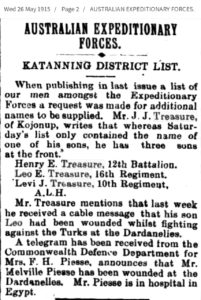
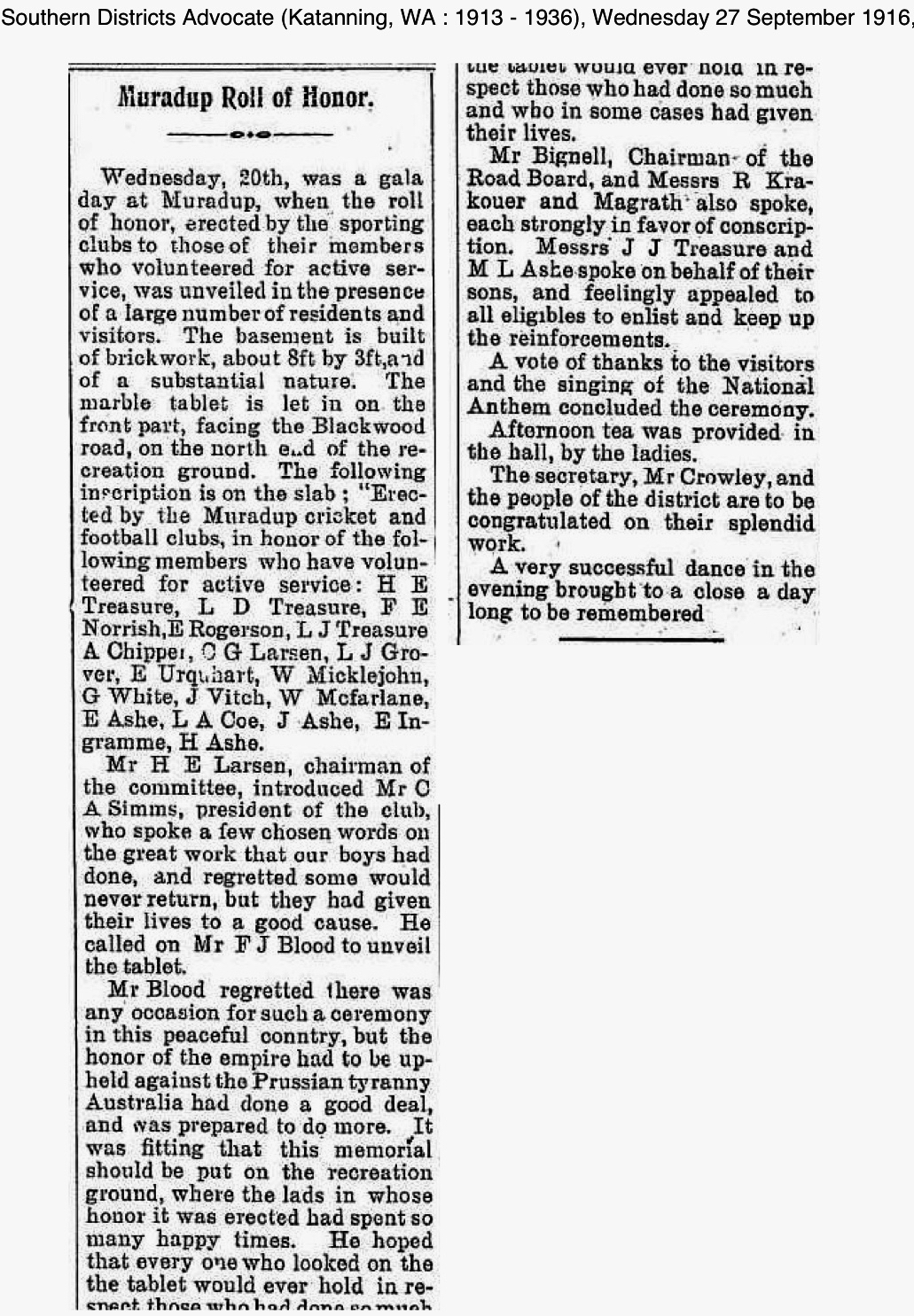
Initially William Meiklejohn and his brother John were in partnership farming at Muradup. John Meiklejohn’s son enlisted with 2/4th MGB – WX9393 John Thomson (Mick) Meiklejohn (Jnr)
John (Jnr) was KIA aged 22 years at Singapore 8 Feb 1942 when the Japanese first invaded the west coast. 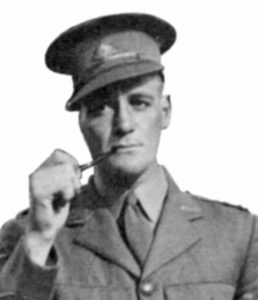
In the company of several of his men from 15 Platoon, Meiklejohn was last seen firing his revolver at a Japanese Corporal whilst fighting their way out of the north west coast where the Australians were quickly overrun.
Meiklejohn enlisted Nov 1941, later joined ‘D’ Coy 2/4th MGB. Lt. Meiklejohn became Commanding Officer of No. 15 Platoon.
His parents John Meiklejohn and Lilian Grace Knable of Mornington Mills married in 1917.

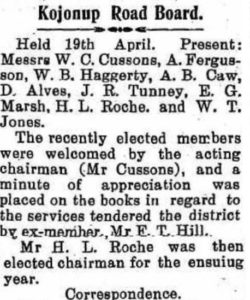
![]()
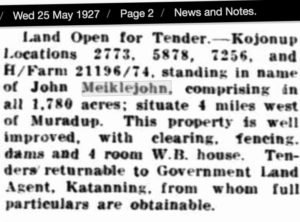
We believe the Meiklejohn Brothers dissolved their partnership when Bill enlisted WW1. Bill however returned to the district taking up the offer of a farm nearer Kojonup where he remained with his family until selling in 1927.
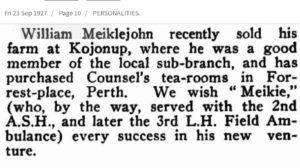
Following are some interesting pieces of news from the Muradup boys:

Letter from Henry Treasure who had been at Gallipoli.
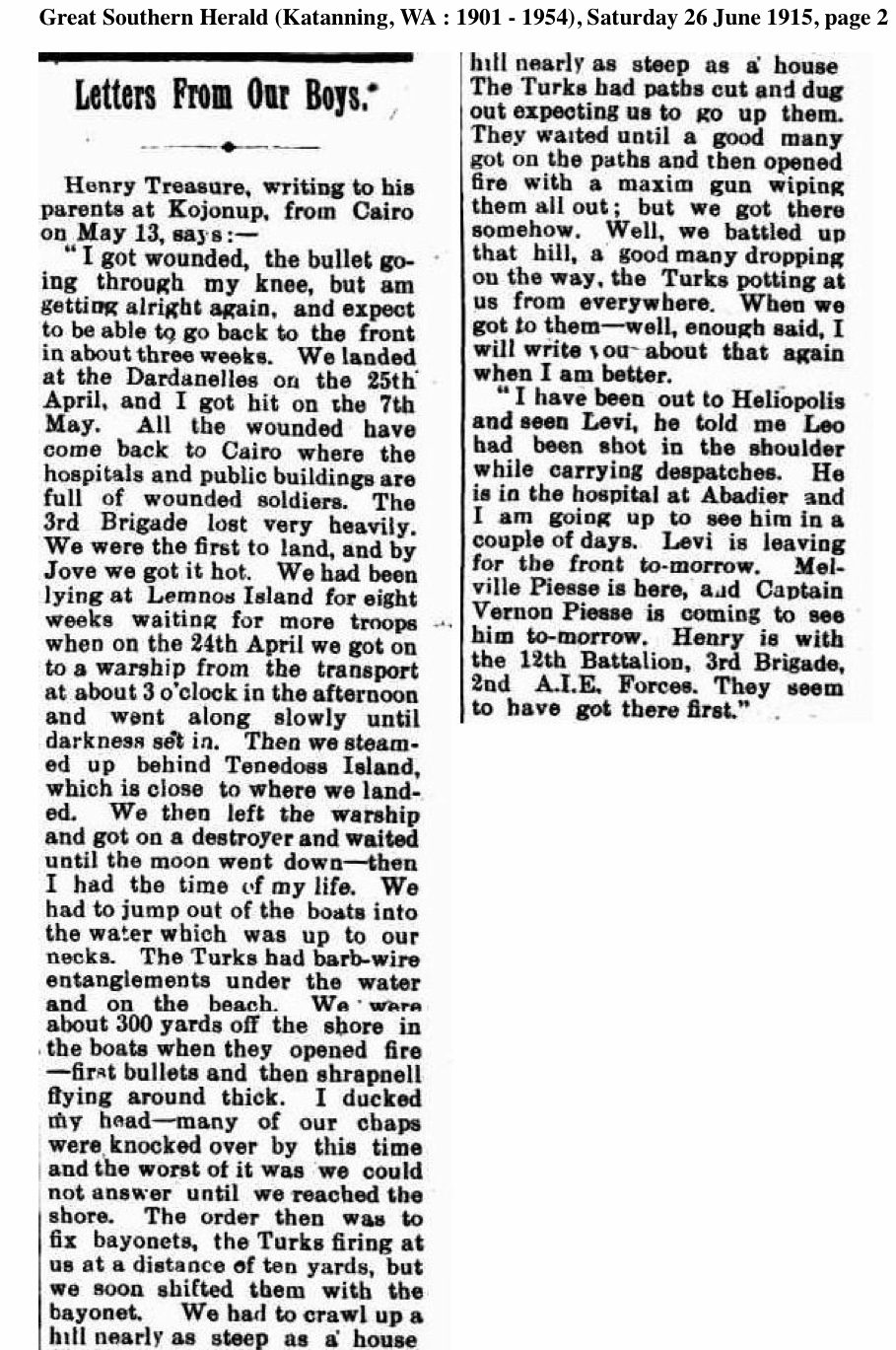
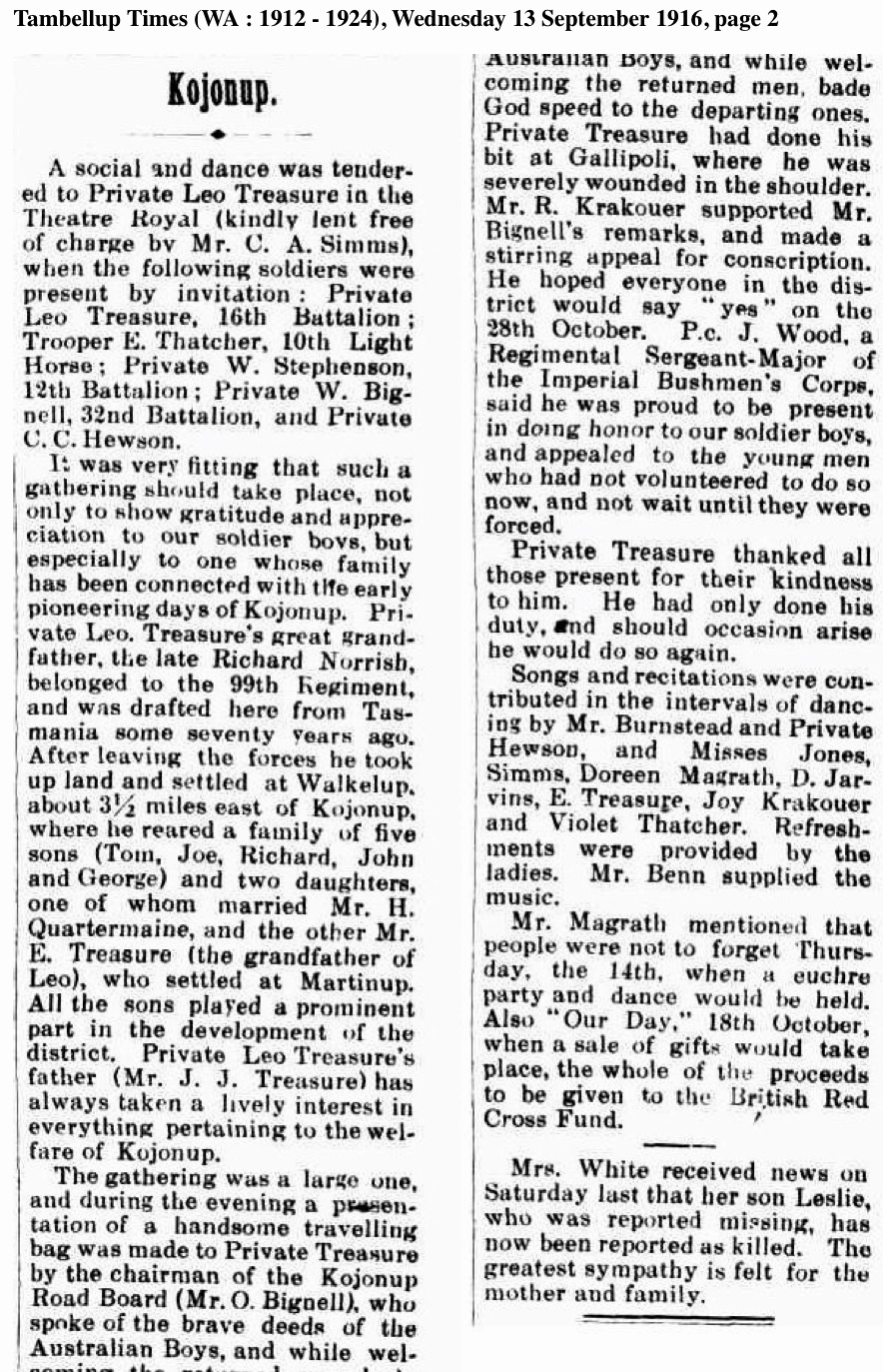
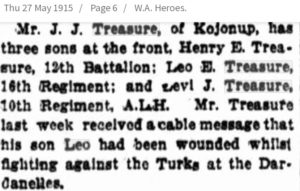
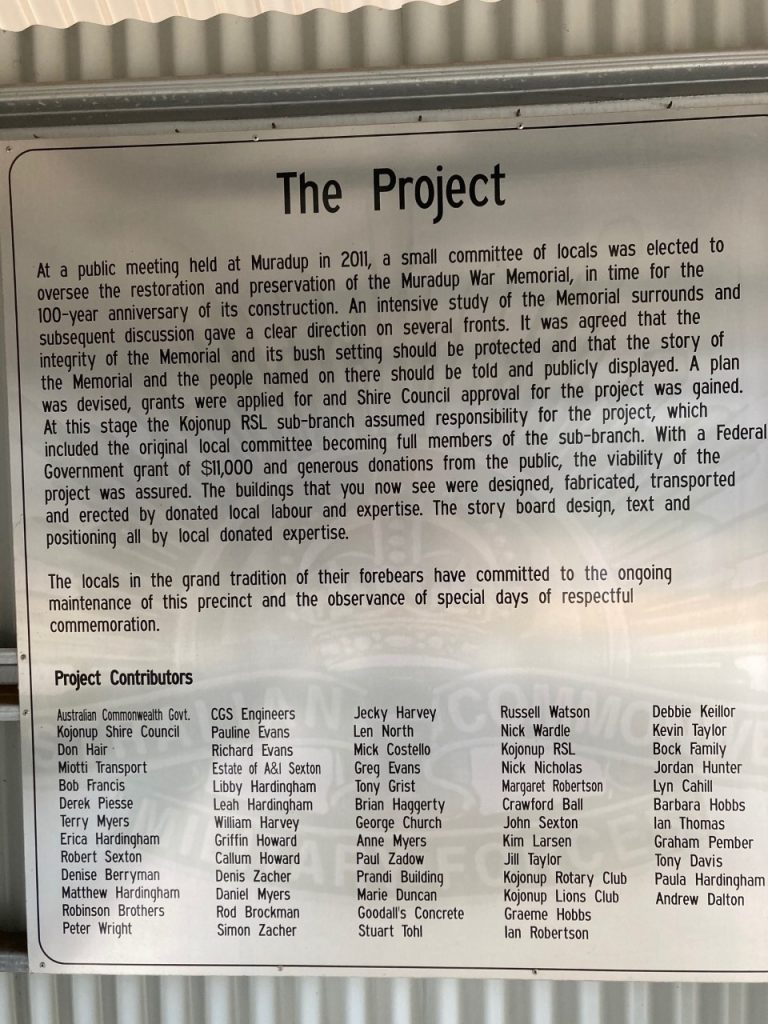
________________________
WX5263 Colin (Keith) McDonald (aka Black Mac) Lance Corporal, ‘C’ Coy, 10 Platoon was born Kojonup 1902 to parents Richard McDonald and Janet Ross. He married Alice ‘Rose’ Halden in 1923.

From Singapore he was selected with ‘A Force Burma Green Force No. 3 Battalion whose main focus was to construct the Burma end of the Burma-Thai Railway. McDonald became part of Williams Force – a mobile work force which moved frequently up and down the rail link often to repair. Please read about Williams Force who suffered a harrowing experience moving from one camp to another usually at night so they could start work that very morning.
Others from the Kojonup area in Green Force were Bob Ritchie of Kulikup and Bert Struthoff who was born in Kojonup 1914 and lived his early formative years at Muradup where his father was first employed as a Fettler with the WAGR and later purchased his own small property.
At the end of the war McDonald was recovered from Thailand. He returned to is family and Kojonup.
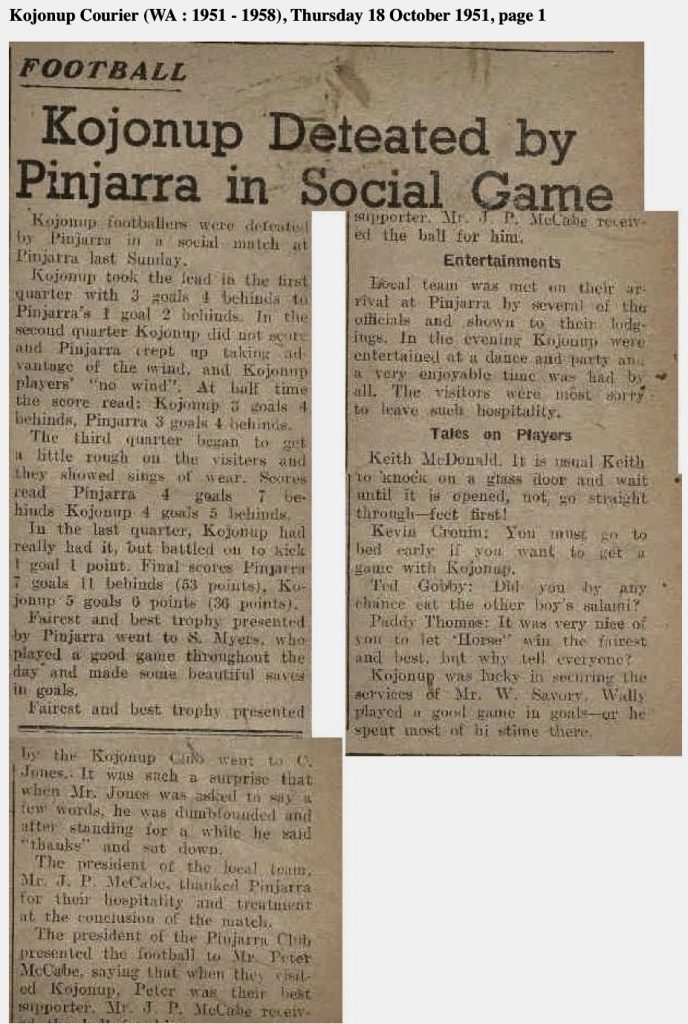
Keith McDonald died at Kojonup in 1973. Both he and his wife were buried at Kojonup.
__________
WX15743 William Robert (Bob) RITCHIE of Kulikup.
He was born in Lisbon, County Antrim, Ireland in 1904 to Parents Robert John and Molly Ritchie. He arrived in WA in the early 1920s. He took up sheep farming subsidised by shearing team work. He married Christine ‘Chrissie’ Bock of Kulikup in 1923.
Bob enlisted AIF August 1941 and less than two months later was Taken on Strength to Woodside Camp, SA where he joined 2/4th Battalion ‘C’ Coy 10 Platoon training as a Stretcher Bearer with Battalion Headquarters under Commanding Officer Lt-Col Anketell.
As a POW in Singapore he was included in a 3,000 men work party to sail to Burma called ‘A’ Force Burma, Green Force No. 3 Battalion. First they worked on repairing and enlarged three airfields left by the British on the south west of Burma and then headed to what would become the northern most point of the Burma-Thai Railway.
Ritchie was mentioned in Dispatches and awarded a British Empire Medal for his services in the sick wards of Burma, in particular the isolated and deadly Cholera Wards in Burma’s camps, where tending the sick put you in the firing of the deadly cholera disease.
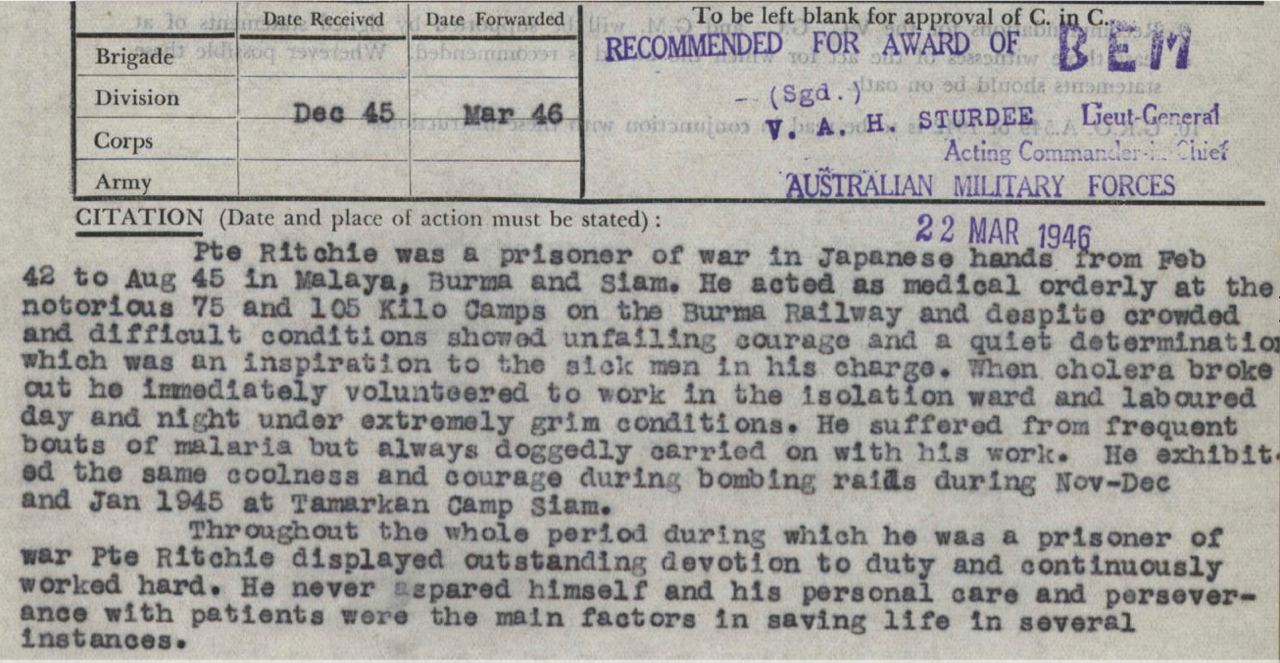
Ritchie returned to farming at Kulikup. About five later he sold in 1950 having settled there some 30 years earlier.
Please read further about Bob Ritchie
Below: Ritchie and Potts receive Army awards.
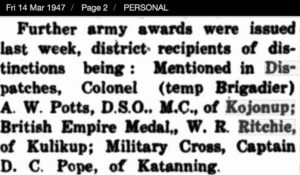
__________
WX15869 Albert ‘Bert’ John STRUTHOFF
b. Kojonup 1914 to John and Ellen Struthoff. His father was member of Farmers & Settlers Association WA, Muradup Branch (c.1917) and had his name included in the newspaper regularly with the Roads Board.
Bert Struthoff enlisted AIF 18 Aug 1941 and was Taken on Strength to Woodside SA to join 2/4th’s ‘C’ Company HQ under Commanding Officer Colin Cameron.
He left Singapore with the first work Party – ‘A’ Force Burma Green Force No. 3 Battalion to work on the Burma end of the Railway.
With the bulk of the Railway completed during late 1943 the Japanese began moving all POWs working at the Burma end of the rail southwards to Thailand to one of the larger camps. This is where Bert was included with the work party to go to Japan – known as ‘Rakuyo’ Maru. The ‘Rakuyo’ Party entrained at Thailand for Saigon, French Indo China – then Japan’s busiest shipping port to supply their front line in northern Burma. The POWs were accommodated at the former French Foreign Legion Barracks and sent out on local work parties. They had several ‘false’ starts for departing Saigon, but each time returned to their Barracks. The Americans had by now effectively blockaded Saigon and its port – the river entrance was littered with sunken shipping, the open seas were home to US Submarines. The Japanese then decided to send the POWs by train back to Singapore. Another long and dangerous journey as both American and British planes were regularly bombing the rail, Japan’s stockpiles and places like Bangkok.
As the POWs were gathering for their departure, Bert Struthoff and two other 2/4th POWs were found to be seriously ill and unable to travel. They were left behind. Bert died on 19 September 1944 of pneumonia aged 30 years at Saigon, and was buried at Tan Son Nhut, French Indo-China.
Please read about Saigon, French Indo China.
(Tragically the ‘Rakuyo’ Maru was sunk by American submarines 12 Sept 1944, resulting in the deaths of most on board including 38 men from 2/4th.)
__________
WX9351 John ‘Jack’ TREASURE born 1919
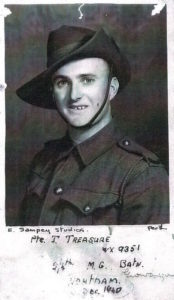 the first born child to parents Leo Edward Treasure and Victoria Jenkins who married in 1918. Jack enlisted AIF in October 1940, later joined 2/4th MGB’s HQ No. 3 Platoon as a Driver.
the first born child to parents Leo Edward Treasure and Victoria Jenkins who married in 1918. Jack enlisted AIF in October 1940, later joined 2/4th MGB’s HQ No. 3 Platoon as a Driver.
John (Jack) Treasure played in 2/4th MG football team. The footy team included some excellent players, from the Goldfields and well known League players such as Joe Pearce, Lou Daley, Helmrich and Mussman.
As a POW in Singapore Jack was sent on work parties to Pulau Blakang Mati and Adam Park before returning to Selarang Barracks. He was selected with ‘D’ Force Thailand V Battalion to work on the Thai end of the Railway.
Please read about V Battalion who were to endure possibly the highest death rate of 2/4th men on the Burma-Thai Railway. Jack was 24 years old when he died of cerebral malaria at Kuii Camp on 13 Sept 1943. There were simply no medical supplies.
Kui
A total of 52 men including 21 machine gunners died at this camp. On 18th December 1943 the remaining officer Major Alf Cough and 18 other ranks from the original party were evacuated to Non Pladuk. Three of these men died within 3 days of their arrival.
Jack’s brother Ronald Edward also enlisted in WW2. He returned to Australia and lived until 1986
2/4th’s Corporal Colin Heppell WX9348 was a driver for Col. Anketell. He died Kuii POW Camp 6 Oct 1943 of Colitis aged 38 years just 3 weeks after Jack. Colin Heppel and his wife owned and ran the Gnowangerup Store.
Please read further about Kuii Camp where Jack and Colin Heppel died of illness.
We have included Jack Treasure’s memory with Kojonup/Muradup area because his father Leo Treasure was one of the original Muradup Cricketers who gathered together to establish the Muradup War Memorial.
Jack’s name has been included with the 2/4th men from Gnowangerup, Tambellup and Ongerup.
Please read further the history of Gnowangerup, railway and other places of interest.
___________________
KOJONUP WAR MEMORIAL
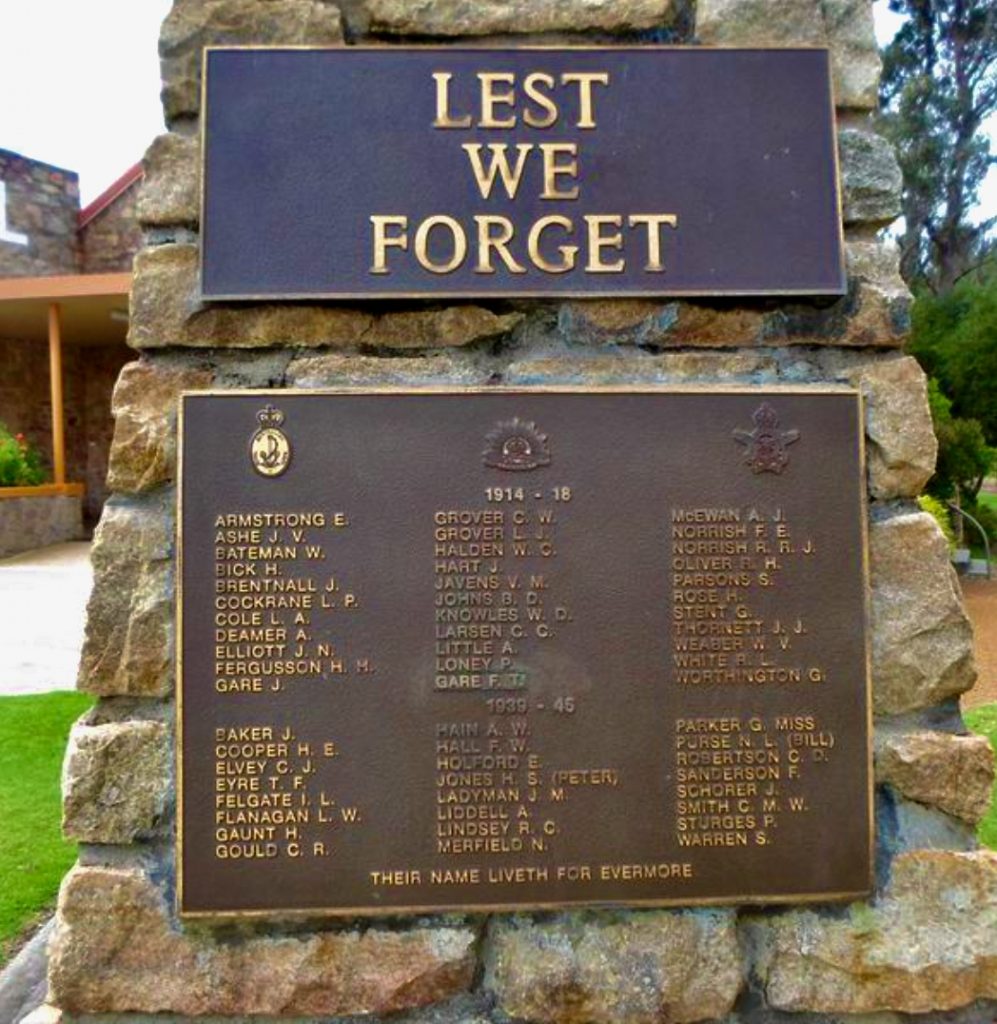
There is the story of Percy Gratwick and his VC in the grounds of the Kojonup RSL’s Commemoration Way. WX20426 Gratwick was KIA during the attack at Miteiriya, El Alamein in Egypt’s Western Desert on 26 Oct 1942 aged 40 years. Private Gratwick was fighting with Australia’s 2/48th Infantry Battalion.
VC’s were awarded to 20 Australians in WW2.
His VC medal is on display at the WA Military Museum, Fremantle.
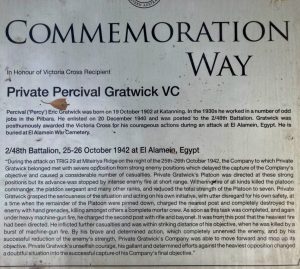
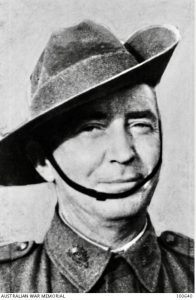
Further research confirms Percy Gratwick’s father was Postmaster at Katanning, however died very young in 1911 leaving the family struggling. Percy was the fifth son. He was educated at Katanning, Boulder and Perth leaving school at 16 years. His first job was a messenger at Parliament House.
In about 1922 Percy headed north to the Pilbara where he learnt droving and blacksmithing. As a station hand he built up a droving plant made up mostly of aboriginal men, took up contracting until about the drought beginning in 1931. Percy then went prospecting settling in mid 1930’s at Wodgina, a tantalite mine, blacksmithing, prospecting and sometimes working cattle at White Springs . He is described as ‘being his own man, well used to looking after himself in that tough country’. (Australian Dictionary of Biography)
5ft 10″ tall of medium build, Percy was ‘quiet and resourceful, a practical joker, a bachelor who loved children, a bushman who thought city people had profit-and-loss minds. He measured people by their actions.’
Percy Gratwick lies in the desert of El Alamein war cemetery, plot 22, row A, grave 6.
Please read further about Percy Gratwick, a great Western Australian
Below: From RSL’s Listening Post, August 2003
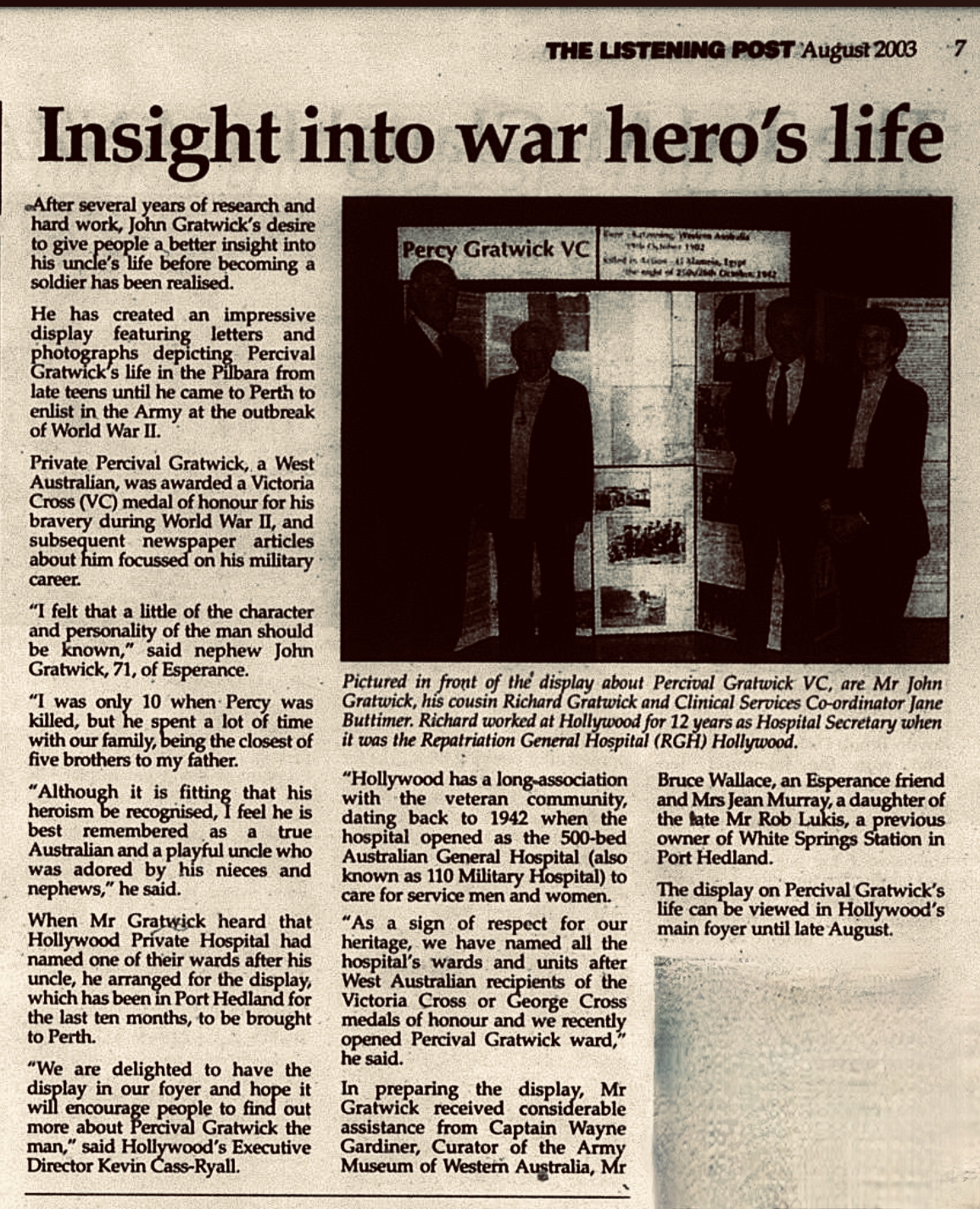
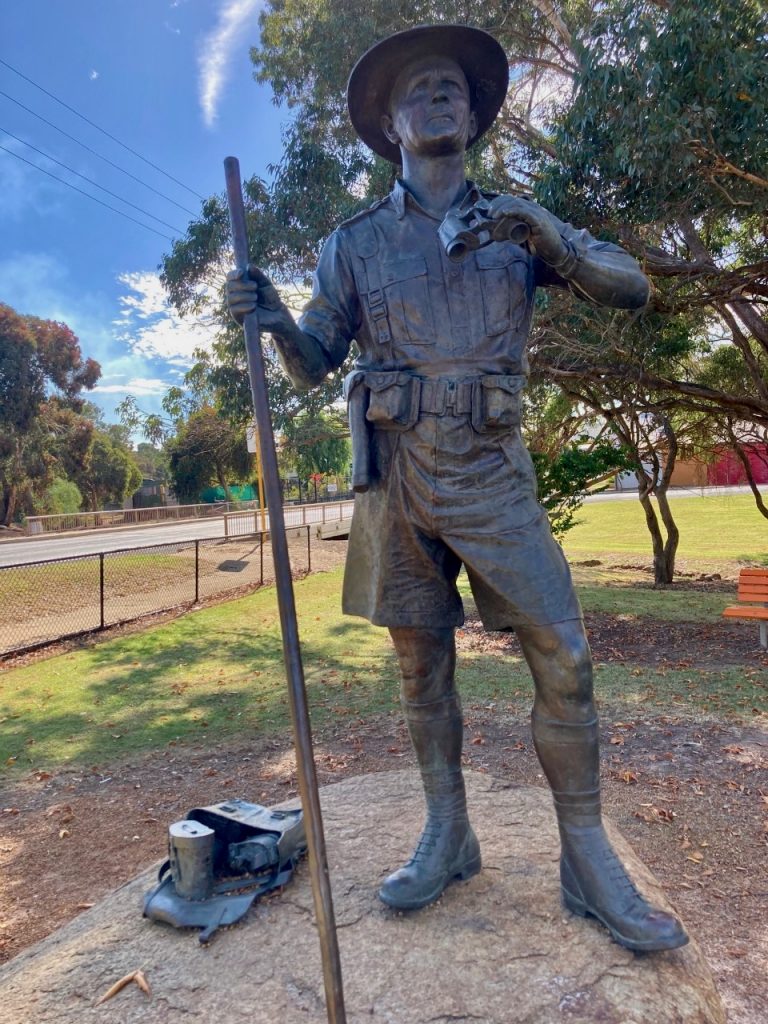
Above: the statue of Arnold William POTTS (DSO, OBE, MC, MiD) Brigadier, 2nd/16th Infantry Battalion, AIF (Army WW2) a veteran of WW1 and enormously honoured by his men of 21st Brigade which in August 1943 ‘he was ordered to take the village of Kokoda. With few supplies and only two exhausted militia battalions and some Papuan troops, Potts went on the defensive. Joined by some AIF battalions, the fighting on the Kokoda Trail became a series of fighting withdrawals: always buying time and lengthening the Japanese supply lines. Reinforcements trickled in but Potts was forced back towards Port Moresby. Conducting a battle in conditions so hostile they were beyond the ability of headquarters staff to imagine, Potts came under criticism for his conduct of the battle. He was recalled to Port Moresby in September 1942. Although he rejoined his brigade, Potts was believed unfairly relieved of his command on 22 October and treated most shabbily.
Potts resumed farming at Kojonup at the end of the war. He died on 1 Jan 1968 at Kojonup.
Even today, the remaining members of 2/16th and military historians work to clear Potts name in Australia’s history books.

Please read further about Brigadier Potts
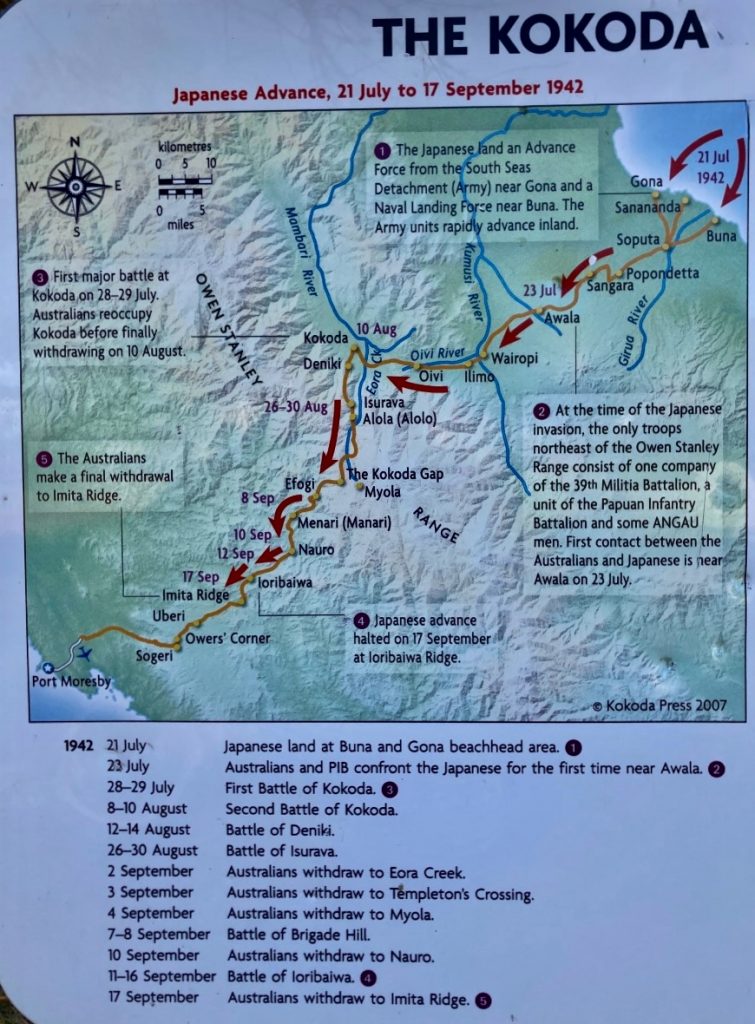
Below: Anzac Day Kojonup March 2021
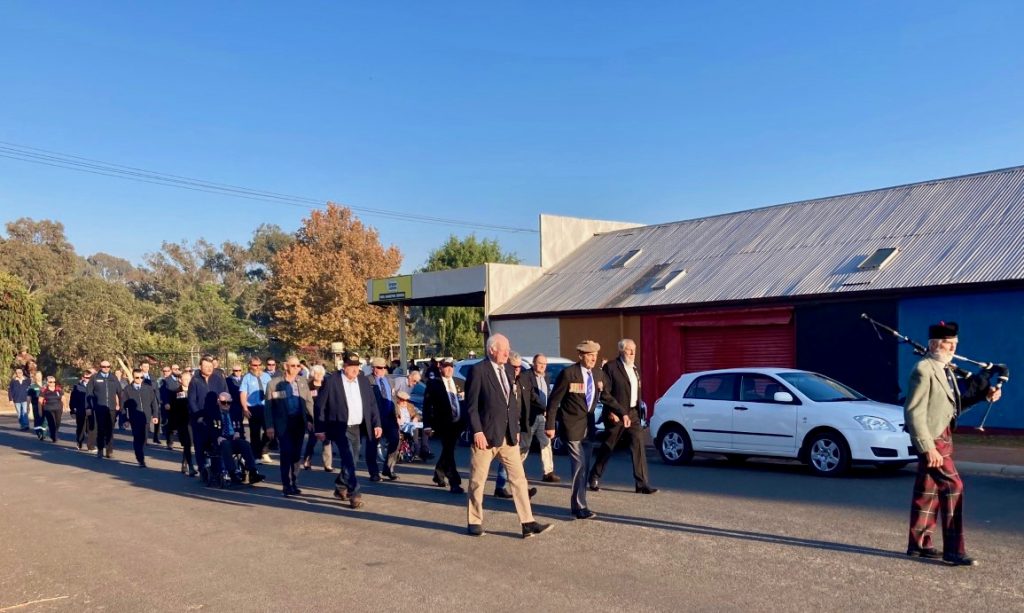
‘It was my great honour to be invited to address Anzac Day 2021 at Kojonup and Muradup (18 kms apart). A large contingent of local men (in the vicinity of 60) marched from the Kojonup town hall to the War Memorial accompanied by the bagpipes.
Mrs Cheryl Mellor of 2/4th MGB and daughter of late Joe Matthews who farmed Boscabel-Chittenup – was invited to address the Kojonup Anzac Day Service and later at Muradup.
Joe Matthews known as ‘Cowboy’ was with 2/4th MGB who joined 8th Division at Singapore. The 8th Division were taken POWs of Japan 15 Feb 1942 – the men sent to more than 200 POW Camps throughout south east Asia, Burma-Thai Railway and Japan. The survivors were not freed until after 15 August 1945, 3 1/2 years later.
Below: Cheryl Mellor with Muradup RSL President, Robert Sexton.


